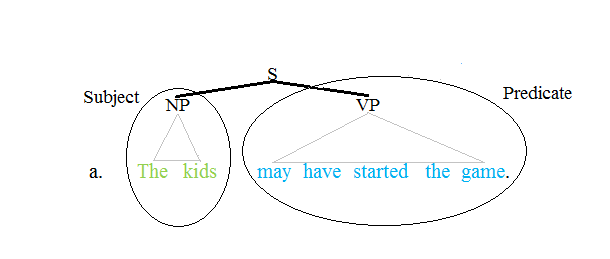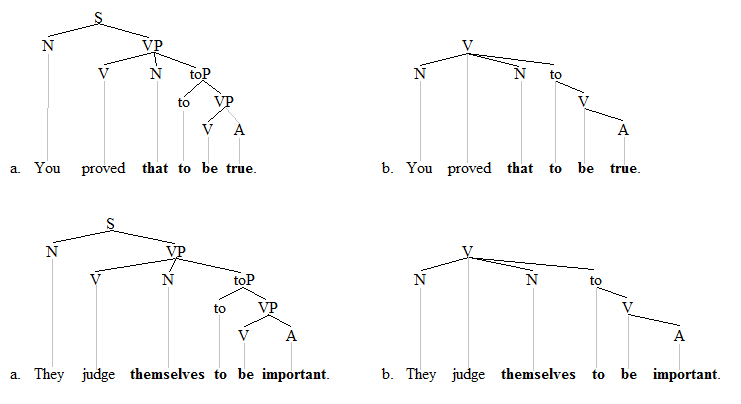|
Argument Control
In linguistics, control is a construction in which the understood subject of a given predicate is determined by some expression in context. Stereotypical instances of control involve verbs. A superordinate verb "controls" the arguments of a subordinate, nonfinite verb. Control was intensively studied in the government and binding framework in the 1980s, and much of the terminology from that era is still used today. In the days of Transformational Grammar, control phenomena were discussed in terms of ''Equi-NP deletion''. Control is often analyzed in terms of a null pronoun called ''PRO''. Control is also related to raising, although there are important differences between control and raising. Most if not all languages have control constructions and these constructions tend to occur frequently. Examples Standard instances of (obligatory) control are present in the following sentences: ::Susan promised to help us. - Subject control with the obligatory control predicate ''promise'' ... [...More Info...] [...Related Items...] OR: [Wikipedia] [Google] [Baidu] |
Linguistics
Linguistics is the scientific study of human language. It is called a scientific study because it entails a comprehensive, systematic, objective, and precise analysis of all aspects of language, particularly its nature and structure. Linguistics is concerned with both the cognitive and social aspects of language. It is considered a scientific field as well as an academic discipline; it has been classified as a social science, natural science, cognitive science,Thagard, PaulCognitive Science, The Stanford Encyclopedia of Philosophy (Fall 2008 Edition), Edward N. Zalta (ed.). or part of the humanities. Traditional areas of linguistic analysis correspond to phenomena found in human linguistic systems, such as syntax (rules governing the structure of sentences); semantics (meaning); morphology (structure of words); phonetics (speech sounds and equivalent gestures in sign languages); phonology (the abstract sound system of a particular language); and pragmatics (how soc ... [...More Info...] [...Related Items...] OR: [Wikipedia] [Google] [Baidu] |
Control Trees 2
Control may refer to: Basic meanings Economics and business * Control (management), an element of management * Control, an element of management accounting * Comptroller (or controller), a senior financial officer in an organization * Controlling interest, a percentage of voting stock shares sufficient to prevent opposition * Foreign exchange controls, regulations on trade * Internal control, a process to help achieve specific goals typically related to managing risk Mathematics and science * Control (optimal control theory), a variable for steering a controllable system of state variables toward a desired goal * Controlling for a variable in statistics * Scientific control, an experiment in which "confounding variables" are minimised to reduce error * Control variables, variables which are kept constant during an experiment * Biological pest control, a natural method of controlling pests * Control network in geodesy and surveying, a set of reference points of known geospatial co ... [...More Info...] [...Related Items...] OR: [Wikipedia] [Google] [Baidu] |
Catenative Verb
In English and other languages, catenative verbs are verbs which can be followed within the same clause by another verb. This second subordinated verb can be in either the infinitive (both full and bare) or gerund forms. An example appears in the sentence ''He deserves to win the cup'', where "deserve" is a catenative verb which can be followed directly by another verb, in this case a ''to-infinitive'' construction. These verbs are called "catenative" because of their ability to form chains in catenative constructions. For example: ''We need to go to the tennis court to help Jim to get some practice before the game. "Need" is used here as a catenative verb followed by the infinitive "to go", and "help" is a catenative verb followed by the infinitive "to get". Use of a catenative verb can be masked by hendiadys, in which the two parts are joined by an ''and'', as in ''come and get it'' rather than ''come to get it''. Form of the verb following the catenative verb *Some caten ... [...More Info...] [...Related Items...] OR: [Wikipedia] [Google] [Baidu] |
Predicate (grammar)
The term predicate is used in one of two ways in linguistics and its subfields. The first defines a predicate as everything in a standard declarative sentence except the subject, and the other views it as just the main content verb or associated predicative expression of a clause. Thus, by the first definition the predicate of the sentence ''Frank likes cake'' is ''likes cake''. By the second definition, the predicate of the same sentence is just the content verb ''likes'', whereby ''Frank'' and ''cake'' are the arguments of this predicate. Differences between these two definitions can lead to confusion. Syntax Traditional grammar The notion of a predicate in traditional grammar traces back to Aristotelian logic. A predicate is seen as a property that a subject has or is characterized by. A predicate is therefore an expression that can be ''true of'' something. Thus, the expression "is moving" is true of anything that is moving. This classical understanding of predicate ... [...More Info...] [...Related Items...] OR: [Wikipedia] [Google] [Baidu] |
Phrase Structure Grammar
The term phrase structure grammar was originally introduced by Noam Chomsky as the term for grammar studied previously by Emil Post and Axel Thue ( Post canonical systems). Some authors, however, reserve the term for more restricted grammars in the Chomsky hierarchy: context-sensitive grammars or context-free grammars. In a broader sense, phrase structure grammars are also known as ''constituency grammars''. The defining trait of phrase structure grammars is thus their adherence to the constituency relation, as opposed to the dependency relation of dependency grammars. Constituency relation In linguistics, phrase structure grammars are all those grammars that are based on the constituency relation, as opposed to the dependency relation associated with dependency grammars; hence, phrase structure grammars are also known as constituency grammars. Any of several related theories for the parsing of natural language qualify as constituency grammars, and most of them have been de ... [...More Info...] [...Related Items...] OR: [Wikipedia] [Google] [Baidu] |
Dependency Grammar
Dependency grammar (DG) is a class of modern grammatical theories that are all based on the dependency relation (as opposed to the ''constituency relation'' of phrase structure) and that can be traced back primarily to the work of Lucien Tesnière. Dependency is the notion that linguistic units, e.g. words, are connected to each other by directed links. The (finite) verb is taken to be the structural center of clause structure. All other syntactic units (words) are either directly or indirectly connected to the verb in terms of the directed links, which are called ''dependencies''. Dependency grammar differs from phrase structure grammar in that while it can identify phrases it tends to overlook phrasal nodes. A dependency structure is determined by the relation between a word (a head) and its dependents. Dependency structures are flatter than phrase structures in part because they lack a finite verb phrase constituent, and they are thus well suited for the analysis of languag ... [...More Info...] [...Related Items...] OR: [Wikipedia] [Google] [Baidu] |
Idiom
An idiom is a phrase or expression that typically presents a figurative, non-literal meaning attached to the phrase; but some phrases become figurative idioms while retaining the literal meaning of the phrase. Categorized as formulaic language, an idiom's figurative meaning is different from the literal meaning. Idioms occur frequently in all languages; in English alone there are an estimated twenty-five million idiomatic expressions. Derivations Many idiomatic expressions were meant literally in their original use, but sometimes the attribution of the literal meaning changed and the phrase itself grew away from its original roots—typically leading to a folk etymology. For instance, the phrase "spill the beans" (meaning to reveal a secret) is first attested in 1919, but has been said to originate from an ancient method of voting by depositing beans in jars, which could be spilled, prematurely revealing the results. Other idioms are deliberately figurative. For example, " brea ... [...More Info...] [...Related Items...] OR: [Wikipedia] [Google] [Baidu] |
Expletive Pronoun
A dummy pronoun is a deictic pronoun that fulfills a syntactical requirement without providing a contextually explicit meaning of its referent. As such, it is an example of exophora. Dummy pronouns are used in many Germanic languages, including German and English. Pronoun-dropping languages such as Spanish, Portuguese, Chinese, and Turkish do not require dummy pronouns. A dummy pronoun is used when a particular verb argument (or preposition) is nonexistent (it could also be unknown, irrelevant, already understood, or otherwise "not to be spoken of directly") but when a reference to the argument (a pronoun) is nevertheless syntactically required. For example, in the phrase "It is obvious that the violence will continue", ''it'' is a dummy pronoun, not referring to any agent. Unlike a regular pronoun of English, it cannot be replaced by any noun phrase. The term ''dummy pronoun'' refers to the function of a word in a particular sentence, not a property of individual words. Fo ... [...More Info...] [...Related Items...] OR: [Wikipedia] [Google] [Baidu] |
Exceptional Case-marking
Exceptional case-marking (ECM), in linguistics, is a phenomenon in which the subject of an embedded infinitival verb seems to appear in a superordinate clause and, if it is a pronoun, is unexpectedly marked with object case morphology (''him'' not ''he'', ''her'' not ''she'', etc.). The unexpected object case morphology is deemed "exceptional". The term ''ECM'' itself was coined in the Government and Binding grammar framework although the phenomenon is closely related to the accusativus cum infinitivo constructions of Latin. ECM-constructions are also studied within the context of raising. The verbs that license ECM are known as ''raising-to-object'' verbs. Many languages lack ECM-predicates, and even in English, the number of ECM-verbs is small. The structural analysis of ECM-constructions varies in part according to whether one pursues a relatively flat structure or a more layered one. Examples The ECM-construction is licensed by a relatively small number of verbs in English (e.g. ... [...More Info...] [...Related Items...] OR: [Wikipedia] [Google] [Baidu] |
X-bar Theory
In linguistics, X-bar theory is a model of phrase-structure grammar and a theory of syntactic category formation that was first proposed by Noam Chomsky in 1970Chomsky, Noam (1970). Remarks on Nominalization. In: R. Jacobs and P. Rosenbaum (eds.) ''Reading in English Transformational Grammar'', 184–221. Waltham: Ginn. and further developed by Ray Jackendoff (1974, 1977a, 1977bJackendoff, Ray (1977b) Constraints on Phrase Structure Rules, in P. W. Culicover, T. Wasow & A. Akmajian (eds.), ''Formal Syntax'', Academic Press, New York, pp. 249–83.), along the lines of the theory of generative grammar put forth in the 1950s by Chomsky. It attempts to capture the structure of phrasal category, phrasal categories with a single uniform structure called the X-bar schema, basing itself on the assumption that any phrase in natural language is an XP (X phrase) that is headed by a given syntactic category X. It played a significant role in resolving issues that phrase structure rules had, r ... [...More Info...] [...Related Items...] OR: [Wikipedia] [Google] [Baidu] |
Antecedent (grammar)
In grammar, an antecedent is an expression (word, phrase, clause, sentence, etc.) that gives its meaning to a proform (pronoun, pro-verb, pro-adverb, etc.). A proform takes its meaning from its antecedent; e.g., "John arrived late because traffic held him up." The pronoun ''him'' refers to and takes its meaning from ''John'', so ''John'' is the antecedent of ''him''. Proforms usually follow their antecedents, but sometimes they precede them, in which case one is, technically, dealing with postcedents instead of antecedents. The prefix ''ante-'' means "before" or "in front of", and ''post-'' means "after" or "behind". The term ''antecedent'' stems from traditional grammar. The linguistic term that is closely related to ''antecedent'' and ''proform'' is '' anaphora''. Theories of syntax explore the distinction between antecedents and postcedents in terms of binding. Examples Almost any syntactic category can serve as the antecedent to a proform. The following examples illustrate a ... [...More Info...] [...Related Items...] OR: [Wikipedia] [Google] [Baidu] |

.png)
.jpg)


.png)